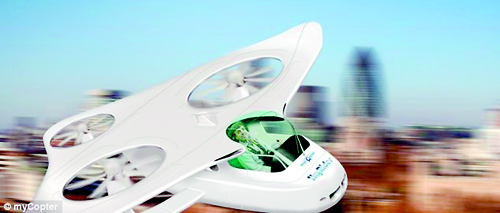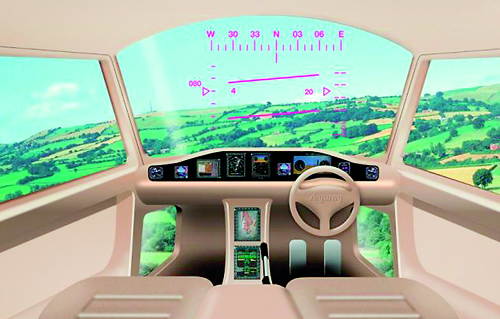Sunday Times 2
Forget the self-driving car, how about a self-flying helicopter?
While Google and others have focussed on self driving cars, a European project aims to go one better – with a one seater personal helicopter that can fly itself.

Researchers hope that by developing personal helicopters such as this concept, congestion could be eased in major cities. The craft would pilot themselves, even being able to spot potential landing sites on top of buildings. Pic © myCopter
The MyCopter project hopes the one seater craft could allow commuters to simply tell the craft where they want to go.
The craft can even spot potential landing sites from the air, and ask the pilot to simply tap they one they want to land it.
By flying below 2000 feet, the new traffic system hopes to operate outside of controlled airspace, without ground-based traffic control and without impacting on existing air traffic.
Six research institutions across Europe are studying the feasibility of the small commuter helicopters, with a $4.7 million grant from the European government.
‘Considering the prevailing congestion problems with ground-based transportation and the anticipated growth of traffic in the coming decades, a major challenge is to find solutions that combine the best of ground-based and air-based transportation,’ the researchers say.
‘The optimal solution would consist in creating a personal air transport system (PATS) that can overcome the environmental and financial costs associated with all of our current methods of transport. ‘

Researchers hope to make the craft as easy to fly as driving a car, with smart software able to take over many of the basic functions. Pic © myCopter
The key to the project is making the craft easy to fly.
‘Several issues need to be resolved before a Personal Aerial Transportation System can be realised,’ the research team admit.
‘An effective human machine interface (HMI) and Training needs to be created, full or partial autonomous behaviour of a flying vehicle needs to be established (which reduces the risk to the pilot and enables the PAV to be flown by the average person), and finally the social and economical impact of a PAV and its ideal design for acceptance by society at large needs to be investigated.’
The researchers hope the MyCopter will be used primarily by commuters – and say it could even mean roads are no longer needed.
‘Such a system will have a beneficial impact on our daily lives and will help to solve many issues related to current traffic and environmental problems, ‘ they claim.
‘First, a large amount of driver/passenger time and frustration can be saved by a PATS as it would no longer require occupants to sit in traffic queues and would allow the possibility of direct travel between two points.
‘Second, travelling directly point to point could save on fuel and would reduce the stop and go traffic that wastes large amounts of energy.
‘Travelling conveniently in the third dimension from door-to-door is a direction that might allow for less congestion and would not require the maintenance of support structures such as roads currently necessary for mass transit.
© Daily Mail, London
| HOW IT WILL WORK
Autonomous flying system will allow craft to fly itself for most of the journey. Can land and take off on its own. Craft can even spot potential landing sites from the air, and ask the pilot to simply tap the one they want to land on. |

